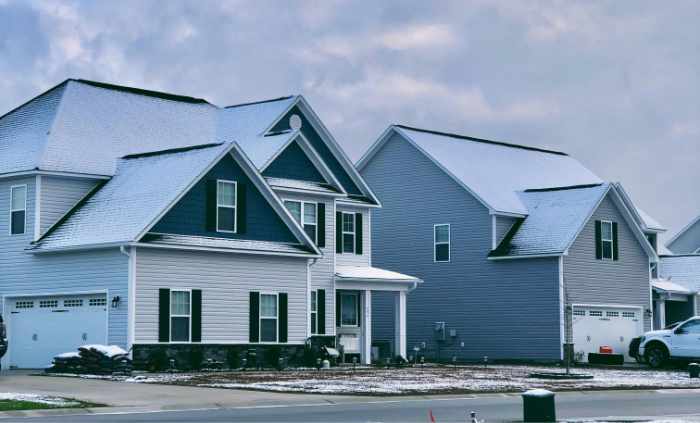Winter can be a magical time with snow-covered landscapes and cozy nights by the fire, but it also brings unique challenges for homeowners. One of the most significant risks during the colder months is slip and fall accidents, for the homeowner and any guests or visitors to their property. Today we have a guide to winter weather risks to explore common winter slip and fall hazards and practical steps you can take as a homeowner to minimize these risks.

Homeowner’s Guide to Winter Weather Risks
As temperatures drop and snow or ice begins to accumulate, ensuring that your home remains safe becomes critical.
Understanding Slip and Fall Risks in Winter
Snow, ice, and freezing rain create hazardous conditions that increase the likelihood of slip-and-fall accidents. Even small patches of ice on walkways or driveways can lead to serious injuries. Here are the five most common items in our guide to winter weather risks:
- Icy driveways and sidewalks: When snow melts and refreezes, it creates slippery patches that can be difficult to detect.
- Slippery stairs and porches: Steps and porches are particularly dangerous if they accumulate ice or become wet from melting snow.
- Uncleared walkways: Neglecting to remove snow or ice buildup on walkways and paths can make them treacherous.
- Fallen leaves or debris: Combined with ice or snow, leaves or other outdoor debris create a hazardous, slippery surface.
- Roof or gutter leaks: If water drips from the roof or clogged gutters and freezes on walkways, it can cause black ice, which is often invisible and extremely slick.
Your Responsibilities as a Homeowner
Homeowners have a legal and ethical responsibility to keep their property safe, including taking precautions during the winter. If someone is injured on your property due to unsafe conditions, you may be liable for any medical bills or damages. Understanding your local laws regarding snow and ice removal is essential, as these can vary by region. In some areas, homeowners are required to clear sidewalks and driveways within a specific time frame after snowfall.
In addition to legal obligations, maintaining a safe property in winter also ensures the safety of your family and visitors.
Winter Safety Tips to Prevent Slips and Falls
Check out our winter home maintenance checklist and read on about some proactive steps you can take to reduce the risk of slips and falls on your property this winter:
1. Clear Snow and Ice Promptly
Shovel snow from driveways, sidewalks, and walkways as soon as possible after a storm. Applying salt, sand, or an ice melt product can help reduce the chances of ice forming. Pay particular attention to high-traffic areas like stairs, entryways, and any surfaces that receive frequent foot traffic.
2. Use Salt and Ice Melt Effectively
Salt or de-icing products can help break down ice and make surfaces less slippery. Be sure to apply it liberally on steps, driveways, and other potentially hazardous areas. Keep extra supplies on hand for any unexpected storms.
3. Install Handrails and Proper Lighting
Ensure that handrails on stairs or entryways are sturdy, providing critical support for people walking on potentially slippery surfaces. Additionally, proper lighting can help guests see icy patches and navigate more safely.
4. Fix Drainage Issues
If water from your roof, downspouts, or gutters tends to pool on walkways or driveways, it can freeze and form ice patches. Make sure that drainage systems are functioning properly and that water is directed away from pathways.
5. Place Mats and Rugs Indoors
When guests enter your home, they may track in snow and water, which can lead to slippery floors. Place absorbent mats or rugs inside entryways to prevent these hazards, and regularly check for wet areas that may need to be dried.
6. Trim Overhanging Branches
Heavy snow or ice accumulation on tree branches can cause them to break and fall, potentially blocking pathways or creating additional hazards. Be sure to trim overhanging branches before winter storms arrive.
7. Hire Professional Help if Needed
If snow or ice buildup is too much for you to manage on your own, consider hiring a professional snow removal service. This ensures that your property remains safe, even during heavy snowfalls.
What to Do If Someone Slips on Your Property
Despite your best efforts, accidents can happen. If someone slips and falls on your property, take the following steps:
- Assist the injured person: Help them up if possible and offer to call for medical assistance if needed.
- Document the incident: Take pictures of the area where the accident occurred, noting any conditions such as ice, snow, or water that may have contributed to the fall.
- Report the incident: Depending on the severity of the injury, you may need to report it to your homeowner’s insurance company. Be honest and provide any necessary documentation, such as photos and medical reports.
- Contact a legal professional: If the person is seriously injured and considering legal action, it’s important to consult with a slip and fall accident attorney who can advise you on your rights and responsibilities as a homeowner.
Winter brings many joys, but it also comes with added risks, particularly when it comes to slip and fall accidents. As a homeowner, we hope our guide to winter weather risks will help you take proactive steps to clear snow and ice, maintain safe pathways, and address any potential hazards. Safety first! By being diligent and prepared, you can prevent accidents and ensure that your home remains a safe haven throughout the winter months.



